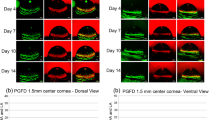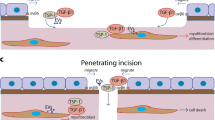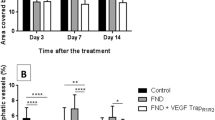Abstract
This protocol describes a powerful in vivo method to quantitatively study the formation of new lymphatic vessels in the avascular cornea without interference of pre-existing lymphatics. Implantation of 100 ng of lymphangiogenic factors such as vascular endothelial growth factor (VEGF)-A, VEGF-C or fibroblast growth factor-2, together with slow-release polymers, into a surgically created micropocket in the mouse cornea elicits a robust lymphangiogenic response. Newly formed lymphatic vessels are detected by immunohistochemical staining of the flattened corneal tissue with lymphatic endothelial-specific markers such as lymphatic vessel endothelial hyaluronan receptor-1; less-specific markers such as vascular endothelial growth factor receptor 3 may also be used. Lymphatic vessel growth in relation to hemangiogenesis can be readily detected starting at day 5 or 6 after pellet implantation and persists for ∼14 d. This protocol offers a unique opportunity to study the mechanisms underlying lymphatic vessel formation, remodeling and function.
This is a preview of subscription content, access via your institution
Access options
Subscribe to this journal
Receive 12 print issues and online access
$259.00 per year
only $21.58 per issue
Buy this article
- Purchase on Springer Link
- Instant access to full article PDF
Prices may be subject to local taxes which are calculated during checkout



Similar content being viewed by others
References
Cao, Y. Opinion: emerging mechanisms of tumour lymphangiogenesis and lymphatic metastasis. Nat. Rev. Cancer 5, 735–743 (2005).
Alitalo, K., Tammela, T. & Petrova, T.V. Lymphangiogenesis in development and human disease. Nature 438, 946–953 (2005).
Makinen, T. et al. Inhibition of lymphangiogenesis with resulting lymphedema in transgenic mice expressing soluble VEGF receptor-3. Nat. Med. 7, 199–205 (2001).
Cao, R. et al. Hepatocyte growth factor is a lymphangiogenic factor with an indirect mechanism of action. Blood 107, 3531–3536 (2006).
Cao, R. et al. PDGF-BB induces intratumoral lymphangiogenesis and promotes lymphatic metastasis. Cancer Cell 6, 333–345 (2004).
Bjorndahl, M. et al. Insulin-like growth factors 1 and 2 induce lymphangiogenesis in vivo. Proc. Natl. Acad. Sci. USA 102, 15593–15598 (2005).
Cao, R. et al. Comparative evaluation of FGF-2-, VEGF-A-, and VEGF-C-induced angiogenesis, lymphangiogenesis, vascular fenestrations, and permeability. Circ. Res. 94, 664–670 (2004).
Kubo, H. et al. Blockade of vascular endothelial growth factor receptor-3 signaling inhibits fibroblast growth factor-2-induced lymphangiogenesis in mouse cornea. Proc. Natl. Acad. Sci. USA 99, 8868–8873 (2002).
Cao, Y. et al. Vascular endothelial growth factor C induces angiogenesis in vivo. Proc. Natl. Acad. Sci. USA 95, 14389–14394 (1998).
Joukov, V. et al. Proteolytic processing regulates receptor specificity and activity of VEGF-C. EMBO J. 16, 3898–3911 (1997).
Bjorndahl, M.A. et al. Vascular endothelial growth factor-a promotes peritumoral lymphangiogenesis and lymphatic metastasis. Cancer Res. 65, 9261–9268 (2005).
Bruyere, F. et al. Modeling lymphangiogenesis in a three-dimensional culture system. Nat. Methods 5, 431–437 (2008).
Kerjaschki, D. et al. Lymphatic endothelial progenitor cells contribute to de novo lymphangiogenesis in human renal transplants. Nat. Med. 12, 230–234 (2006).
Ny, A. et al. A genetic Xenopus laevis tadpole model to study lymphangiogenesis. Nat. Med. 11, 998–1004 (2005).
Nagy, J.A. et al. Vascular permeability factor/vascular endothelial growth factor induces lymphangiogenesis as well as angiogenesis. J. Exp. Med. 196, 1497–1506 (2002).
Maruyama, K. et al. Inflammation-induced lymphangiogenesis in the cornea arises from CD11b-positive macrophages. J. Clin. Invest. 115, 2363–2372 (2005).
Rogers, M.S., Birsner, A.E. & D'Amato, R.J. The mouse cornea micropocket angiogenesis assay. Nat. Protoc. 2, 2545–2550 (2007).
Cao, R. et al. Angiogenic synergism, vascular stability and improvement of hind-limb ischemia by a combination of PDGF-BB and FGF-2. Nat. Med. 9, 604–613 (2003).
Bock, F. et al. Improved semiautomatic method for morphometry of angiogenesis and lymphangiogenesis in corneal flatmounts. Exp. Eye. Res. 87, 462–470 (2008).
Cursiefen, C. et al. VEGF-A stimulates lymphangiogenesis and hemangiogenesis in inflammatory neovascularization via macrophage recruitment. J. Clin. Invest. 113, 1040–1050 (2004).
Albuquerque, R.J. et al. Alternatively spliced vascular endothelial growth factor receptor-2 is an essential endogenous inhibitor of lymphatic vessel growth. Nat. Med. 15, 1023–1030 (2009).
Nakao, S. et al. Lymphangiogenesis and angiogenesis: concurrence and/or dependence? Studies in inbred mouse strains. FASEB J. 24, 504–513 (2010).
Regenfuss, B. et al. Genetic heterogeneity of lymphangiogenesis in different mouse strains. Am. J. Pathol. 177, 501–510 (2010).
Rohan, R.M., Fernandez, A., Udagawa, T., Yuan, J. & D'Amato, R.J. Genetic heterogeneity of angiogenesis in mice. FASEB J. 14, 871–876 (2000).
Acknowledgements
Our laboratory was supported through research grants from the Swedish Research Council, the Swedish Cancer Foundation, the Karolinska Institute Foundation, the Karolinska Institute distinguished professor award, the European Union Integrated Project of Metoxia (Project no. 222741) and the European Research Council Advanced Grant ANGIOFAT (Project no. 250021). Y.C. is supported by the Swedish Heart and Lung Foundation.
Author information
Authors and Affiliations
Contributions
Y.C. designed the study. R.C. conducted the experiments. R.C., S.L., H.J., Y.Z., Y.Y., J.H., E.-M.H. and Y.C. analyzed the data. R.C., S.L., H.J., Y.Z., Y.Y., J.H. and Y.C. participated in designing and discussing this study. R.C., S.L. and Y.C. wrote the paper.
Ethics declarations
Competing interests
The authors declare no competing financial interests.
Rights and permissions
About this article
Cite this article
Cao, R., Lim, S., Ji, H. et al. Mouse corneal lymphangiogenesis model. Nat Protoc 6, 817–826 (2011). https://doi.org/10.1038/nprot.2011.359
Published:
Issue Date:
DOI: https://doi.org/10.1038/nprot.2011.359
This article is cited by
-
AIP1 suppresses neovascularization by inhibiting the NOX4-induced NLRP3/NLRP6 imbalance in a murine corneal alkali burn model
Cell Communication and Signaling (2022)
-
Ocular microbiota promotes pathological angiogenesis and inflammation in sterile injury-driven corneal neovascularization
Mucosal Immunology (2022)
-
Lipid droplet degradation by autophagy connects mitochondria metabolism to Prox1-driven expression of lymphatic genes and lymphangiogenesis
Nature Communications (2022)
-
Fluorescent reporter transgenic mice for in vivo live imaging of angiogenesis and lymphangiogenesis
Angiogenesis (2018)
-
Roles of prostaglandins in tumor-associated lymphangiogenesis with special reference to breast cancer
Cancer and Metastasis Reviews (2018)
Comments
By submitting a comment you agree to abide by our Terms and Community Guidelines. If you find something abusive or that does not comply with our terms or guidelines please flag it as inappropriate.



